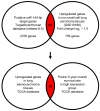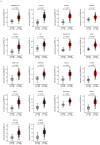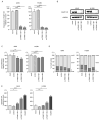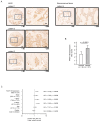Identification of Tumor Suppressive miR-144-5p Targets: FAM111B Expression Accelerates the Malignant Phenotypes of Lung Adenocarcinoma
- PMID: 39337462
- PMCID: PMC11432174
- DOI: 10.3390/ijms25189974
Identification of Tumor Suppressive miR-144-5p Targets: FAM111B Expression Accelerates the Malignant Phenotypes of Lung Adenocarcinoma
Abstract
Accumulating evidence suggests that the passenger strands microRNAs (miRNAs) derived from pre-miRNAs are closely involved in cancer pathogenesis. Analysis of our miRNA expression signature of lung adenocarcinoma (LUAD) and The Cancer Genome Atlas (TCGA) data revealed that miR-144-5p (the passenger strand derived from pre-miR-144) was significantly downregulated in LUAD tissues. The aim of this study was to identify therapeutic target molecules controlled by miR-144-5p in LUAD cells. Ectopic expression assays demonstrated that miR-144-5p attenuated LUAD cell aggressiveness, e.g., inhibited cell proliferation, migration and invasion abilities, and induced cell cycle arrest and apoptotic cells. A total of 18 genes were identified as putative cancer-promoting genes controlled by miR-144-5p in LUAD cells based on our in silico analysis. We focused on a family with sequence similarity 111 member B (FAM111B) and investigated its cancer-promoting functions in LUAD cells. Luciferase reporter assay showed that expression of FAM111B was directly regulated by miR-144-5p in LUAD cells. FAM111B knockdown assays showed that LUAD cells significantly suppressed malignant phenotypes, e.g., inhibited cell proliferation, migration and invasion abilities, and induced cell cycle arrest and apoptotic cells. Furthermore, we investigated the FAM111B-mediated molecular networks in LUAD cells. Identifying target genes regulated by passenger strands of miRNAs may aid in the discovery of diagnostic markers and therapeutic targets for LUAD.
Keywords: FAM111B; lung adenocarcinoma; miR-144-5p; microRNA; passenger strand; tumor-suppressor.
Conflict of interest statement
The authors declare no conflicts of interest.
Figures










Similar articles
-
Involvement of Dual Strands of miR-143 (miR-143-5p and miR-143-3p) and Their Target Oncogenes in the Molecular Pathogenesis of Lung Adenocarcinoma.Int J Mol Sci. 2019 Sep 11;20(18):4482. doi: 10.3390/ijms20184482. Int J Mol Sci. 2019. PMID: 31514295 Free PMC article.
-
FAM64A: A Novel Oncogenic Target of Lung Adenocarcinoma Regulated by Both Strands of miR-99a (miR-99a-5p and miR-99a-3p).Cells. 2020 Sep 11;9(9):2083. doi: 10.3390/cells9092083. Cells. 2020. PMID: 32932948 Free PMC article.
-
miR-186-5p promotes cell growth, migration and invasion of lung adenocarcinoma by targeting PTEN.Exp Mol Pathol. 2019 Jun;108:105-113. doi: 10.1016/j.yexmp.2019.04.007. Epub 2019 Apr 11. Exp Mol Pathol. 2019. PMID: 30981721
-
The Molecular Pathogenesis of Tumor-Suppressive miR-486-5p and miR-486-3p Target Genes: GINS4 Facilitates Aggressiveness in Lung Adenocarcinoma.Cells. 2023 Jul 18;12(14):1885. doi: 10.3390/cells12141885. Cells. 2023. PMID: 37508549 Free PMC article.
-
miR-139-5p Inhibits Lung Adenocarcinoma Cell Proliferation, Migration, and Invasion by Targeting MAD2L1.Comput Math Methods Med. 2020 Nov 4;2020:2953598. doi: 10.1155/2020/2953598. eCollection 2020. Comput Math Methods Med. 2020. Retraction in: Comput Math Methods Med. 2023 Sep 27;2023:9789647. doi: 10.1155/2023/9789647. PMID: 33204298 Free PMC article. Retracted.
Cited by
-
MicroRNA Signatures in Lung Adenocarcinoma Metastases: Exploring the Oncogenic Targets of Tumor-Suppressive miR-195-5p and miR-195-3p.Cancers (Basel). 2025 Jul 15;17(14):2348. doi: 10.3390/cancers17142348. Cancers (Basel). 2025. PMID: 40723231 Free PMC article.
-
The complex role and molecular mechanism of family with sequence similarity genes in cancer: a comprehensive review.Discov Oncol. 2025 Jul 30;16(1):1443. doi: 10.1007/s12672-025-03241-4. Discov Oncol. 2025. PMID: 40736938 Free PMC article. Review.
References
MeSH terms
Substances
Grants and funding
LinkOut - more resources
Full Text Sources
Medical
Molecular Biology Databases

